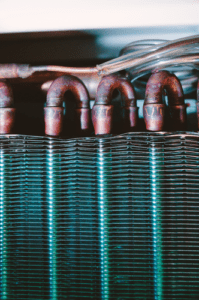With the polar vortex and other extreme winter weather ravaging much of America, the problem of cracked heat exchangers has become front and center. In a furnace, the heat exchanger filters out and vents the gases from the flame of the furnace. It is the device that separates the gases from your breathing air. It is a metal tube or chamber that serves as a passageway that goes from the burner assembly to the chimney vent.  Cracks in a heat exchanger can allow gases, including deadly carbon monoxide, to leak into areas all around the furnace, which in many cases is a home. Prolonged exposure to carbon monoxide can be fatal. Over 400 Americans die every year due to unintentional exposure to poisonous carbon monoxide. Several incidents from the last few weeks highlight the dangers of cracked heat exchangers and carbon monoxide poisoning.
Cracks in a heat exchanger can allow gases, including deadly carbon monoxide, to leak into areas all around the furnace, which in many cases is a home. Prolonged exposure to carbon monoxide can be fatal. Over 400 Americans die every year due to unintentional exposure to poisonous carbon monoxide. Several incidents from the last few weeks highlight the dangers of cracked heat exchangers and carbon monoxide poisoning.
Recent incidents of faulty furnaces and carbon monoxide poisoning
-
-
- Seventy children including infants in cribs had to be evacuated from a daycare center in Milwaukee due to a carbon monoxide leak. The children were taken to a nearby shopping center for their safety and the fire department reportedly found problems with the furnace.
- Two people in Michigan were found dead from carbon monoxide poisoning in their home. A man and his elderly mother were the victims in what authorities say was an incident caused by a faulty furnace.
- State Troopers in New Hampshire discovered two people who had apparently died in their sleep from carbon monoxide poisoning in their home. Several pets including cats and dogs were also found dead.
- In the state of New York, hundreds of people had to be evacuated from a large residential building after firefighters detected carbon monoxide levels that were potentially deadly.
- In Colorado, cracked heat exchangers in furnaces went undetected by two different teams of inspectors and put the lives of several Denver families in danger. The problem was finally solved when a third private company came and found the cracks. This shows the importance of using a reputable heating and air conditioner company.
- A man in North Carolina had to spend several winter nights without central heating after discovering cracks in the heat exchanger in his home. His family was able to survive by using an emergency supply of firewood.
- Last November there were two separate incidents of carbon monoxide poisoning from gas-fired barbecues. In one case, a dozen people were injured by the deadly gas seeping from a charcoal grill that had been brought indoors at night. Two had to be flown by emergency helicopter to the hospital. The residents were saved by the actions of a 15-year-old girl who alerted neighbors in the morning after she realized that everyone in the house was experiencing symptoms of carbon monoxide poisoning.
-
In another case, a barbecue on a terrace in front of a living room caused deadly fumes to leak into the house; after complaining of dizziness and nausea, nine people were taken to the hospital for treatment. One of the big dangers of carbon monoxide poisoning is that the gas is odorless; it can’t be detected by its smell. It’s also colorless, so it can’t be seen as it leaks out of a broken furnace and fills a room or building. Carbon monoxide poisoning happens when the gas builds up in the bloodstream and cuts down on the body’s ability to transport oxygen in the blood. As the oxygen supply gets reduced in the brain, oxygen deprivation can occur very quickly. It can and often does kill people in their sleep, and for all these reasons carbon monoxide poisoning is often referred to as the “silent killer.”
How to Protect Yourself from Carbon Monoxide Poisoning
Authorities urge people to be wary of carbon monoxide poisoning by following these important guidelines:
- Use carbon monoxide detectors in your home, especially in sleeping areas. Keep them in working order and change the batteries often.
- Know the symptoms and be forewarned. Symptoms of carbon monoxide poisoning include dizziness, nausea, headaches, weakness, shortness of breath, confusion and blurred vision experienced by the people exposed to the deadly fumes.
Most importantly, have your furnace regularly checked, repaired and even replaced if necessary by a reputable company that specializes in heating, ventilation and air conditioning. You should visually inspect your furnace for soot, rust and cracks, but doing this doesn’t take the place of regular inspections by professionals. Do it now.

